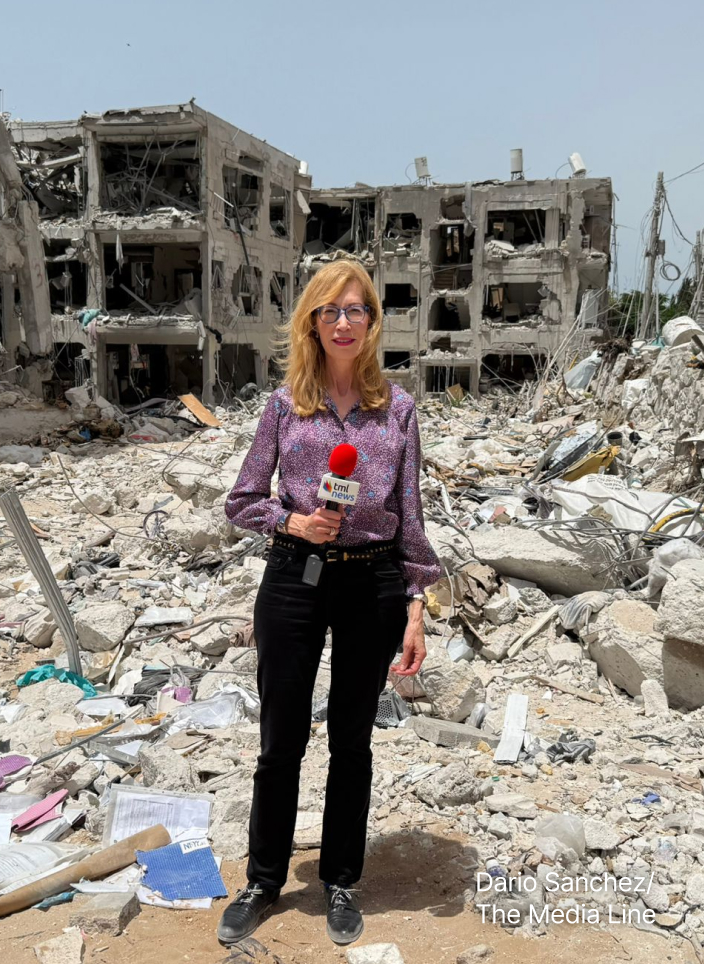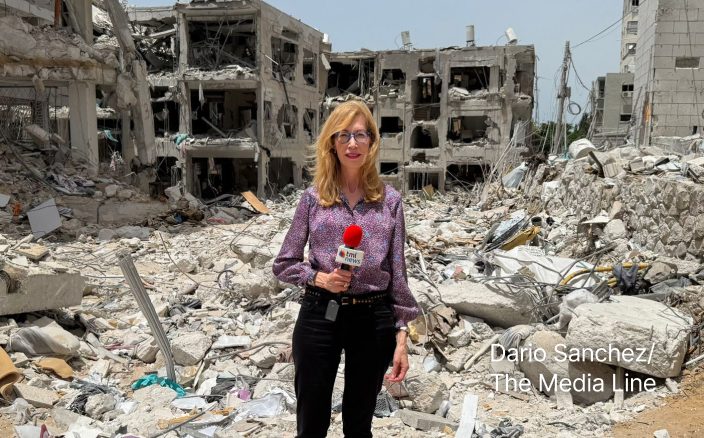Scenes of hundreds of Palestinians crowding for food have become common in Gaza. Videos on social media often show people standing with empty pots and pans, waiting to receive soup or rice. Many leave empty-handed as supplies run out before their turn. Last winter, authorities in Gaza reported that a child and two women were trampled to death in a stampede at a bakery in central Gaza.
The aid crisis in Gaza has become more severe since the war broke out in October 2023.
“Gaza is facing a catastrophic situation,” Tania Hary, executive director of Gisha, an Israeli NGO that focuses on freedom of movement for Palestinians, told The Media Line. “Supplies of everything are dwindling, to the point where there is not enough food in Gaza, not enough flour, and community kitchens and bakeries have shut down.”
Within Israel, a long and heated debate has emerged over whether the country should supply aid to its enemy during wartime. During the administration of former US President Joe Biden, Israel faced intense pressure from the United States to ensure a steady and increased flow of aid to Gaza. This created friction both between the allies and within Prime Minister Benjamin Netanyahu’s far-right government. Senior Israeli military commanders also resisted a proposal from cabinet ministers that the army itself should handle aid distribution.
According to Lianne Pollak-David, a strategic adviser and co-founder of the Israeli Coaltion for Regional Security who previously worked for the Prime Minister’s Office and the National Security Council, Israel’s decades-old security doctrine is not designed for long wars, making the aid issue a novel challenge.
“Israel is not prepared for such long wars and, therefore, should have established a mechanism that secures the aid, making sure it gets to the right hands and not to Hamas,” she told The Media Line.
Gaza is filled not only with images of people scrambling for necessities but also with social media posts claiming Hamas terrorists are seizing aid trucks and shooting at anyone who attempts to access the goods.
Israel has accused Hamas of using humanitarian aid to rebuild its stockpiles and reselling the remaining goods to civilians at inflated prices.
“There is no evidence of significant diversion by Hamas,” said Hary. “Having said that, in a situation of war, the greater the scarcity, the more the value of the goods that do come in creates desperation and criminal motivation on the part of the population.”
“Hamas and others have profited from this scenario, but certainly that is not what happened to the vast majority of the goods which have been consumed by the civilian population,” she added.
The election of US President Donald Trump signaled a shift in Washington’s approach, granting Israel more leeway to use humanitarian aid as leverage against Hamas.
During a visit to the Middle East in mid-May, President Trump acknowledged the growing humanitarian crisis in Gaza, stating that “a lot of people are starving.” His remarks came at the end of his regional tour, concluding in Abu Dhabi, and marked a notable shift in rhetoric. He added that “a lot of good things” could happen soon and emphasized the need to address civilian suffering.
In March, Israel halted the flow of aid into Gaza in an attempt to pressure Hamas to release at least some of the 59 remaining Israeli hostages still held by the terrorist group. Weeks later, Hamas remains entrenched in its demand that all hostages will be released only if Israel ends its military operations and withdraws from the Gaza Strip—conditions Israel has rejected.
Give the gift of hope
We practice what we preach:
accurate, fearless journalism. But we can't do it alone.
- On the ground in Gaza, Syria, Israel, Egypt, Pakistan, and more
- Our program trained more than 100 journalists
- Calling out fake news and reporting real facts
- On the ground in Gaza, Syria, Israel, Egypt, Pakistan, and more
- Our program trained more than 100 journalists
- Calling out fake news and reporting real facts
Join us.
Support The Media Line. Save democracy.


“Israel was mistaken in thinking that as soon as aid would stop flowing, it would be leverage against Hamas by creating pressure from the civilian population in Gaza towards Hamas leadership,” said Pollak-David. “As many of the people in Gaza are frustrated with Hamas, they do not have enough strength to overthrow it.”
Hamas has only strengthened its hold the more the population doesn’t get what it needs
“In fact, Hamas has only strengthened its hold the more the population doesn’t get what it needs,” she added.
On Monday, in a shift prompted by international pressure and growing fears of famine, Israel allowed a limited number of aid trucks to enter Gaza for the first time in nearly three months. The delivery included food staples and baby formula. Israeli officials described it as a humanitarian gesture, but aid organizations said the quantity was nowhere near sufficient to meet the needs of Gaza’s population, which remains in crisis.
The humanitarian situation in Gaza remains dire, prompting the US to seek a workaround while continuing to allow Israel to act according to its own judgment. The plan now is to establish aid distribution centers protected by American security contractors, without Israeli participation. These centers are expected to be located in southern Gaza, in an area Israel has been clearing with military force in recent weeks.
Since resuming operations following a brief ceasefire, the Israeli army has focused on creating the “Morag Corridor,” a strategic east-west route between Rafah and Khan Younis in southern Gaza. The goal is to isolate this area from the rest of Gaza, effectively encircling it and creating a buffer zone cleared of Hamas fighters. The plan is to relocate the population there and allow military freedom of operation in the rest of the Strip. Israel is expected to permit aid distribution in this area, hoping it will reach civilians not involved in the fighting. The plan has already drawn criticism.
“The infrastructure for distribution of aid already exists,” Hary said. “There is no need to reinvent anything. There are dozens of organizations that operate in the Strip already, there are channels for aid to come in, and trucks of food and other items that are just waiting to enter.”
According to Hary, the proposed mechanism is flawed in several ways. It lacks the capacity to respond quickly to Gaza’s urgent needs and will likely fail to reach large segments of the population.
Aid needs to be delivered where it’s needed, and military needs should not be the focus
“It seems very much designed to concentrate the population into areas where it is convenient to Israel,” Hary added. “Aid needs to be delivered where it’s needed, and military needs should not be the focus. There needs to be a balance between the civilian needs and the military objectives.”
Israel remains determined to free the remaining hostages, and Netanyahu saw humanitarian aid as one possible bargaining chip.
“This did not contribute to Israel’s goals, even though it is difficult to imagine our hostages being starved, rotting away in captivity while we are allowing humanitarian aid in,” said Pollak-David. “But in the end, using humanitarian aid as leverage doesn’t work and is a mistake.”
“The hostages must be released, and this is Hamas’s obligation, whether there is an agreement or not,” said Hary. “Israel has an obligation to allow aid for the civilian population and should adhere to its position under international law. It does not want to be on the same playing field as Hamas.”
According to COGAT, the Israeli government body overseeing operations in the Palestinian territories, nearly 1.8 million tons of aid entered Gaza between the start of the war and the end of February 2025, when Israel decided to suspend the aid flow.
On Friday, several United Nations agencies warned that the new mechanism could worsen the humanitarian situation.
UN Children’s Fund spokesperson James Elder said the Israeli-American plan would force Gazans to choose “between displacement and death.”
Humanitarian aid should never be used as a bargaining chip
“It’s dangerous to ask civilians to go into militarized zones to collect rations. … Humanitarian aid should never be used as a bargaining chip,” Elder added, speaking to journalists in Geneva.
“The mechanism is a good idea at this point in time as it is designed to be secure and get the aid where it’s needed,” Pollak-David said. “But in the long run, what is needed is an alternative to Hamas’ rule, and this cannot be created by private contracting firms.”
Israel, for its part, maintains that it is not obligated to provide aid to its enemy during wartime. International legal experts are divided—some argue against this view, while others support it, making humanitarian aid yet another contentious issue between Israelis and Palestinians.
Israel has maintained a blockade on Gaza since Hamas took control of the territory in 2007. The blockade restricts the movement of people and goods, with Israel controlling nearly all access points except the Rafah crossing on the Egyptian border. Materials deemed “dual-use”—such as cement and certain chemicals—have also been barred from entering Gaza for nearly two decades due to their potential military applications.
Since the start of the war, Netanyahu has vowed both to dismantle Hamas and to secure the release of all hostages. Neither objective has been achieved, and two months into a complete aid blockade, Israel appears no closer to fulfilling either of its stated goals.